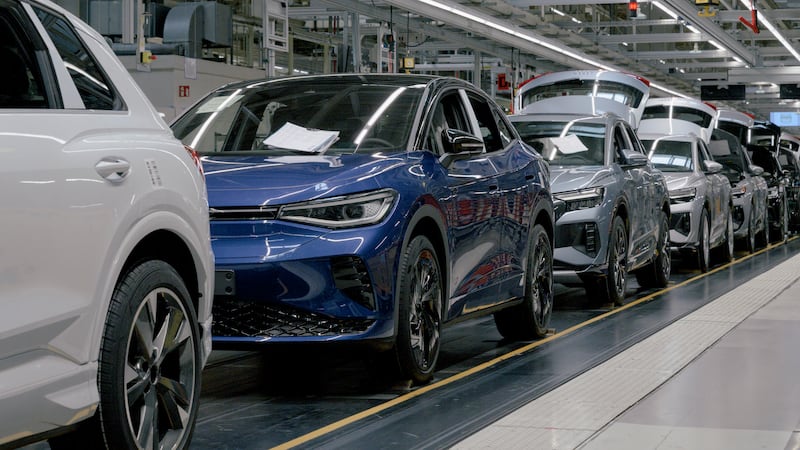BMW chose to mark its centenary with a new concept car, reflecting the great changes ahead for the motor industry. The lack of any concrete detail on how the car may be powered also symbolises the great uncertainty amongst the established players like BMW as to what exactly the future holds.
The VISION NEXT 100 concept has some innovative new features, such as a flexible “skin” that can adjust the shape of the car slightly for the benefit of aerodynamics when out on the open road, and parking when in town.
The car features a retractable steering wheel, reflecting the option of autonomous driving or an assisted driving experience.
0 of 3
For all the self-driving technology espoused by the car, BMW clearly believes its customers will want the option to drive themselves in the future. Whether authorities will allow humans to take control in 100 years time remains to be seen , however.
The car retains the brand’s iconic kidney grilles on the front, although these no longer work as air vents; rather the distinctive grille is home to the myriad of sensors and tech needed to feed the car with data. When will we see anything like it on our roads? That’s far from clear, though some suggest that many of its traits could feature on cars on sale by 2036.
The Vision Next is the first of four concepts due for release this year as part of the centenary for the brand. BMW started out making aeroplane engines in 1916. After the first World War its focus changed to motorcycles and later to cars. It's this ability to shift its engineering focus that the premium brand is hoping will help it tackle the sizeable challenges ahead, not least the search for alternative power sources and the advent of self-driving cars.
The centenary celebrations officially kicked off with an event at Munich’s former Olympic stadium hall, and broadcast to 30,000 employees of the firm at a separate event at the city’s Allianz football stadium on Monday evening.
German chancellor Angela Merkel was due to attend but EU discussions on the refugee crisis meant she had to go to Brussels. What she missed was largely a showcase of buzzwords, an impressive light show and a series of slick dance routines. Strangely BMW seemed to ignore the rich motoring history of the brand - which is impressively on display at the firm's museum across the road from the Olympic Stadium. Instead it opted for a variety of dance routines to represent each brand, with little in the way of motoring metal on display. At times it seemed less a centenary event for a landmark motoring icon and more like some attempt to create a Munich's got Talent stage show.
There was little information on what BMW sees as the future of either the industry or its brands. That is likely to emerge next week when the firm announces its latest set of financial results and unveils a new strategic direction.
Driving pleasure
What detail there was, came in a press conference held in the plant first used to develop the firm’s aircraft engines a century ago.
“In the future, ‘Sheer Driving Pleasure’ will be defined as liberating drivers through automation,” BMW said in a statement. “The company is on the verge of realising automated driving. With it will come a series of technical challenges, but also a major opportunity for revolutionizing mobility.” Vehicles moving autonomously was a question of ‘’when,’’ not “if,’’ BMW said, adding that it sees people still wanting to take over the wheel at times to experience the thrill of driving.
The look into the future comes as the Munich-based carmaker teeters on the edge of losing the top spot in the luxury-car market it’s held since 2005. With sales growth lagging behind No. 2 Mercedes-Benz, BMW is under pressure to show it can still innovate.
BMW Vision Next 100 will allow drivers to select when they want control over the wheel and when they want to do something else, with an interactive windshield that can warn of bicycles, pedestrians or other road obstacles. “BMW drivers will be able to let their cars do the work, but only when the driver wants,” the company said.
Artificial Intelligence
BMW isn’t alone grappling with how digital, urban lifestyles are changing what people expect from a car. The industry is set to experience a “much wider kind of competition” as artificial intelligence makes it possible for vehicles to talk to each other, drive themselves and free up people’s commuting time, Dieter Zetsche, chief executive officer of Mercedes, said last week at the Geneva motor show.
BMW will unveil a major new strategy for the future next week when it presents its latest accounts.
BMW’s last major strategic shift was in 2007, when then-chief executive Norbert Reithofer pushed the sporty brand to invest billions to reduce fuel consumption, produce its first electric vehicle and pioneer the mass-production of carbon fiber.
The youngest head of a major carmaker, Krüger (50) is part of a generational shift that’s now looking for ways to respond to new challengers such as Apple and Google, which the BMW chief executive on Monday described as competitors. “In the not-too-distant future, most vehicles will probably be completely self-driving people will get around in robots on wheels,” BMW said. “How will we justify the existence of vehicles by BMW, a brand for whom the individual and sheer driving pleasure are the focus of everything?”
- Additional reporting: Bloomberg


















